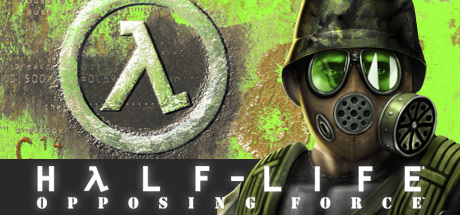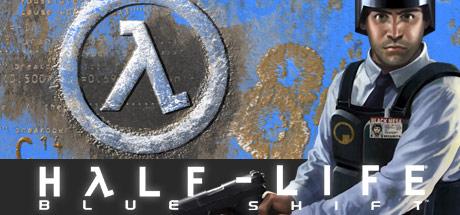As
we previously established, Half Life was
a genre-defining game. Not quite a masterpiece, but one that needs to be
remembered for what it achieved and what modern gaming still needs to catch up
on. Despite the game ending on an open note, many were pleasantly surprised
that Half Life became a franchise.
And it started with two expansion packs.
The
first was Half Life: Opposing Force. Released
in 1999, it was produced not by Valve but Gearbox. In
this expansion, you play as Adrian Shepherd, a marine deployed to the Black
Mesa research facility. You begin en-route to the facility, but you’re shot
down by an alien force before you’re given any orders – so whilst you can kill scientists and security personnel
if you want to, you’re not supposed to.
Things
escalate quickly as, since the marines have failed to control the situation,
the government sends in special forces – who are basically the ninjas from the
first game but with assault rifles. The speed they move makes them really
annoying as they use hit-and-run tactics and take much more damage than average
marines. But also, a new wave of aliens called Race X begins teleporting in.
These guys can hit like a freight train and take as much abuse as one. One of
the hardest and most terrifying parts of the game is a section set in a
pitch-black area filled with the toughest enemies in the game. These guys take
at least three direct hits with a rocket launcher, and they can kill you in two
hits.
 |
| "AAHH! SAVE ME, ALIEN MOUNTED ONTO MY ARM, FROM THIS OTHER ALIEN!!" |
This
feels much more like a Quake sequel
than a Half Life sequel. There’s
nothing wrong with that, and if you want the seamless approach of Half Life but with over-the-top action
then congratulations: you've found the game you've been looking for all this
time. Yet it’s weird being given exposition by a group of soldiers one moment
then circle-strafing around a massive alien.
Another
problem with the game is that there are sections where you can command a group
of marines. This sounds like a great idea, and the marines themselves are able
to deal and take a lot of damage. The problem is that their AI often refuses to
work. They get stuck on doors, they walk in front of your fire, they sometimes
don’t help you out, and they possess very few survival instincts. Likely, your
squad won’t survive beyond one skirmish – which really defeats the point of
this new mechanic.
But
I actually like how this game is different from Half Life. From the moment the game starts and your HUD is green
rather than orange, you know you’re playing a different person. You get a wrench
straight out of Bioshock, and you don’t
have your HEV suit being your only companion. The environments attempt to
explore different areas, and only a couple of times does it feel like Gearbox
is recycling maps from Half Life.
Oh,
and this game has the best tutorial ever. In a time when
designers actually put effort into tutorials rather than having text-boxes flash up, this was the finest and it’s aged
beautifully. Play this game just for the tutorial. I still sometimes go back to it - it's that good.
Next
came Half Life: Blue Shift. It was
again developed by Gearbox Software, and was released almost two years after Opposing Force in 2001. Whilst Opposing Force was desperately behind schedule during development - and it shows in the last level - a load of other developers were called in to help make the game, and this also shows as well. It's a solid shooter that deviates enough from Half Life to give it it's own identify, even if the merging of two well-known styles (narrative-based FPS and old-school FPS) is a bit weird. Blue Shift is the opposite.
You play as Barney Calhoun, who's the security guard knocking on the door in the opening to the Half Life and your BFF in Half Life 2. Unlike Opposing Force, there is no new content. There are a few new locations, but this is Half Life 1.1. You don't even get a new melee weapon...just another crowbar. Often set-pieces from this game have blurred and combined with my memories of the first game. It was funny blasting through Half Life and wondering where a certain section had gone - only to find it here.
You play as Barney Calhoun, who's the security guard knocking on the door in the opening to the Half Life and your BFF in Half Life 2. Unlike Opposing Force, there is no new content. There are a few new locations, but this is Half Life 1.1. You don't even get a new melee weapon...just another crowbar. Often set-pieces from this game have blurred and combined with my memories of the first game. It was funny blasting through Half Life and wondering where a certain section had gone - only to find it here.
 |
| Sadly, you can't cause a time paradox. |
The
game does strongly benefit from new,
updated models and textures. It hugely upgrades the look of Half Life and makes the whole thing
appear more presentable. I also like the new character animations, although
these aren't used as much as they could have been. In fact, it’s only really at
the start of the game you notice things like NPC’s tying their shoelaces or
doing things other than walking and standing around.
I
also like how the game makes you feel utterly disposable. You begin the game
being locked out of the facility, and the scientists all treat you like crap
because you’re not the savior of the world, or an advanced marine – you’re
just a security guard who’s having a really bad day. The opening scene where
you’re trapped in a lift during the disaster is also a terrifying sequence that
draws you into the game perhaps more so than the previous two. Whilst Opposing Force begun a few hours after
the first game begins, Blue Shift starts
at exactly the same time – so it’s great seeing the events of Half Life from a different perspective.
In
fact, the feeling of being at the bottom of society really is the best part of
the game. Later you’ll encounter a scientist who you have to look after – and,
whilst he’s a likable character who you want to keep alive, the fact that you
need to keep him alive reminds you that ultimately he’s superior to you. He’s
the last hope for his scientist friends, not you. You’re just a guy who can shoot
a gun. The scientists could leave you behind and any moment, but they’re letting
you tag along out of kindness.
But
this is the only thing that makes you feel like you’re playing someone else. Since
you’re given a crowbar, you might as well be Gordon Freeman without the HEV
suit – which is why it’s so baffling that when the scientists send you to Xen (for
no real reason other than: “You went there in the original game”) they give you
absolutely no protection so in reality you should immediately die from exposure
to the vacuum of space.
Whilst
the game makes an effort to introduce new set pieces, the whole experience
blurs in my memory because the game is three hours long. That’s frankly
pathetic. Considering the first game is at least ten, and Opposing Force is about five – that’s a huge problem.
I feel odd. My main criticism with Opposing Force is that deviates from Half Life, but my main criticism with Blue Shift is that it doesn't deviate from Half Life. If anyone who worked on these games is reading this, they probably want to shove a crowbar up my nether-regions.
If you must play one, play Opposing Force. You don't really need to play Blue Shift unless you get it as part of a sale bundle like I did. Although, aside from the tutorial, I wouldn't really classify Opposing Force as a 'must play' game. But you're an individual. You can make your own mind up.
I feel odd. My main criticism with Opposing Force is that deviates from Half Life, but my main criticism with Blue Shift is that it doesn't deviate from Half Life. If anyone who worked on these games is reading this, they probably want to shove a crowbar up my nether-regions.
If you must play one, play Opposing Force. You don't really need to play Blue Shift unless you get it as part of a sale bundle like I did. Although, aside from the tutorial, I wouldn't really classify Opposing Force as a 'must play' game. But you're an individual. You can make your own mind up.
 |
| "It's me, Gordon! Barney from Black Mesa! I have a voice and personality now! What do you have? Huh? HUH?!" |





